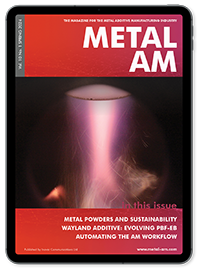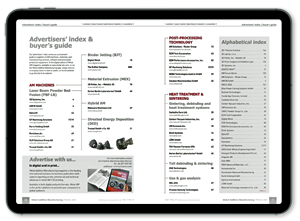Metal Additive Manufacturing is rapidly gaining momentum across a broad range of industries and is often used for producing components for challenging applications such as medical implants and rocket engines. To maximise the mechanical strength and fatigue resistance of such critical AM parts, they must be processed by Hot Isostatic Pressing (HIP) to eliminate any residual porosity, and heat treated. Jim Shipley from Quintus Technologies provides an overview of HIP and High Pressure Heat Treatment technology for Powder Bed Fusion AM and considers the opportunities that a new generation of HIP equipment presents.
... Read more »
Two worlds collide in Additive Manufacturing. Consider that a Laser Beam Powder Bed Fusion (PBF-LB) machine completes its job fully automatically over many hours. Yet, before and after that, a multitude of manual tasks often still need to be completed. Employees may be required to perform these tasks while wearing personal protective equipment (PPE) to protect themselves from metal dust, compounded by the high labour costs that this manual work incurs. Is this the future of cost-efficient, 24/7 production? Christian Mittmann and Manuel Henser, from Volkmann GmbH, believe that the real solution can be found in the complete automation of powder handling.
... Read more »
Kennametal is a particularly interesting company when it comes to the adoption of Additive Manufacturing. It is a dynamic global producer of tooling and industrial materials with sales of $2 billion in 2022, yet its roots are very much in ‘old school’ sinter-based PM processes. It is, therefore, no surprise that the company was an early adopter of AM, leveraging its materials and sintering expertise, as well as its broad customer base, to develop a leading position in the AM of hardmetals and steels. Bernard North, who fortuitously happens to be a past VP Industrial Technology at Kennametal, visited the company’s AM operation and reports for Metal AM magazine.
... Read more »
Additive Manufacturing offers the opportunity to transform industrial production. Currently, however, AM components are typically produced in only one material, which in many cases does not allow for full performance utilisation. In this article, Xiaoshuang Li and Arthur Seibel describe, through a heat sink case study, how multi-material design and manufacturing can increase component performance as well as integrate additional functionalities when using the Laser Beam Powder Bed Fusion (PBF-LB) process.
... Read more »
So much is discovered when it just all goes wrong. From a ‘design-fail-fix’ perspective, it’s expected that developmental components may be pushed to destruction. With rocket engines that operate near the limits of their performance, however, the need to understand the causes of a failure is critical. In the competitive commercial space business there’s a clear advantage not to disclose knowledge gained from such incidents. Thankfully, NASA can share what others cannot. Here, Alison Park, Deputy Technical Fellow, Materials and Additive Manufacturing, and Paul Gradl, Principal Engineer, share insights into one failure.
... Read more »
The Additive Manufacturing industry is in a state of continual evolution. As one group of processes moves towards widespread adoption, others are being introduced and refined. In such a dynamic environment, how do we define AM, and what does ‘good’ AM look like? This article considers the status quo of conventional manufacturing before comparing key AM processes. Steven Camilleri, Andrew Duguid, Sam Katz and Chris Massar (SPEE3D), Martin McMahon (MAM Solutions), Victor Champagne (US Army Research Laboratory), Ozan Özdemir (Northeastern University), Anthony Naccarelli and Timothy Eden (Penn State), Krishnan Kannoorpatti (Charles Darwin University) and Bruce McLean (University of Sydney) unravel AM’s value metrics.
... Read more »
A technical session at the World PM2022 Congress & Exhibition, organised by the European Powder Metallurgy Association (EPMA) and held in Lyon, France, October 9-13, 2022, focused on the corrosion and wear resistance of materials processed using beam-based Additive Manufacturing. This session comprised three papers which looked at ways to improve these properties – both particular pain points for AM’s wider adoption – by way of chemical-mechanical surface polishing, adjusted laser power, and the development of new, wear-resistant alloys for AM. Dr David Whittaker reviews the presented papers.
... Read more »
When NanoAL, LLC, a company with a decade of aluminium alloy development experience, decided to speed up its development of alloys for AM, it turned to SLM Solutions’ SLM®125 PBF-LB machine. As NanoAL’s Matthew Simmers explains, the company needed a workhorse machine that fulfilled a number of requirements, from open parameters and material flexibility to specifications and build quality that closely mirrored larger, production-focused machines. This article explores machine choice, installation, and operation in supporting NanoAL’s Rapid Alloy Screening (RAS) process.
... Read more »
Alloy development has evolved dramatically throughout history, from what was a game of ‘trial and error’ to a systematic approach driven by Design of Experiments and specialist software. Now, the adoption of Integrated Computational Materials Engineering (ICME) is once again changing the way new materials are developed and deployed in today’s advanced manufacturing technologies. QuesTek’s Keith Fritz, Director of Solutions Architecture, details how the company’s ICMD® platform is enabling faster, cheaper and more successful development of new alloys for metal Additive Manufacturing, as well as the build parameters to process them.
... Read more »
The use of metal AM is ramping up, and so, as a result, is the demand for metal powders. However, the variety of materials available remains relatively small. This is due, among other things, to the exacting requirements for the powders used, and the method of production. In addition, the production of smaller quantities of powder can be uneconomical. In a project funded by the AiF, the IWM at Germany’s RWTH Aachen University and Fraunhofer IFAM have developed a sustainable ‘powder kit’ for the individual and robust production of metal powder mixtures with subsequent alloying during PBF-LB processing. The partners share their progress.
... Read more »
Additive Manufacturing processes offer a high degree of design freedom. The Laser Beam Powder Bed Fusion of metals (PBF-LB/M), in particular, has established itself for series applications of complex-shaped parts in numerous industries. In this article, Prof Dr-Ing Christian Seidel considers the next major step in PBF-LB, which could offer designers unknown potential: the production of sensor-integrated AM parts. Methods and solutions for the manufacturing of sensor-integrated AM parts are presented and industry-relevant case studies showcased, illustrating the potential offered by sensor-integrated ‘smart parts.’
... Read more »
While most people associate the advantages of AM with small- to medium-sized, complex parts, wire-based Directed Energy Deposition (DED) makes it possible to achieve geometric complexity on a huge scale. Although the adoption rate for wire-based DED does not come close to that of the more widely known metal AM processes, this unique technology has advanced dramatically over recent years, and promises major advantages in a volatile global manufacturing landscape. Dr Filomeno Martina, CEO and co-founder of WAAM3D, explains more.
... Read more »





Join our community